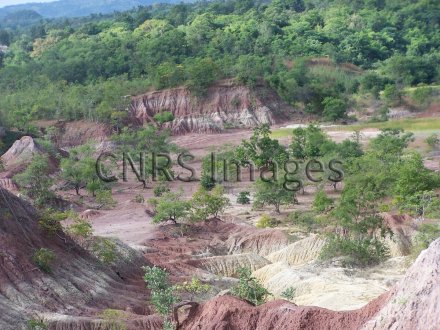Production year
2005

© Laurent MARIVAUX/ISEM/CNRS Images
20090001_1072
Localité fossilifère de Paukkaung n°4 au Myanmar dévoilant les affleurements typiques de la formation de Pondaung : une alternance de dépôts argileux-sableux allant du rouge au jaune, en passant par le blanc. Ce sont des dépôts sédimentaires vieux de 37 millions d'années, déposés dans une plaine alluviale qui drainait un immense fleuve, très certainement, le paléo-Irrawaddy. Au coeur de la jungle birmane, ces localités fossilifères sont en fait des "spots" de déforestation locale, subissant les effets des fortes précipitations annuelles de la mousson d'Asie. Cela donne un paysage naturel, appelé "bad land", ou "Kyitchaung" en birman. Recherches paléontologiques sur l'origine asiatique des primates anthropoïdes, les premiers rameaux de nos origines.
The use of media visible on the CNRS Images Platform can be granted on request. Any reproduction or representation is forbidden without prior authorization from CNRS Images (except for resources under Creative Commons license).
No modification of an image may be made without the prior consent of CNRS Images.
No use of an image for advertising purposes or distribution to a third party may be made without the prior agreement of CNRS Images.
For more information, please consult our general conditions
2005
Our work is guided by the way scientists question the world around them and we translate their research into images to help people to understand the world better and to awaken their curiosity and wonderment.